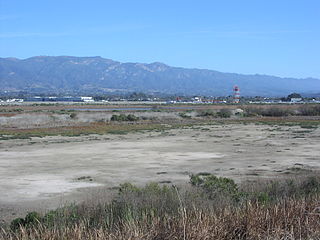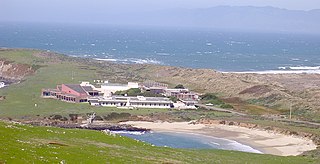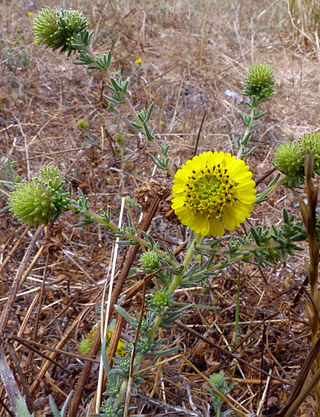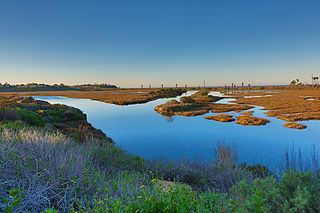
Point Reyes National Seashore is a 71,028-acre (287.44 km2) park preserve located on the Point Reyes Peninsula in Marin County, California. As a national seashore, it is maintained by the US National Park Service as an important nature preserve. Some existing agricultural uses are allowed to continue within the park. Clem Miller, a US Congressman from Marin County, wrote and introduced the bill for the establishment of Point Reyes National Seashore in 1962 to protect the peninsula from development which was proposed at the time for the slopes above Drake's Bay.

The Goleta Slough is an area of estuary, tidal creeks, tidal marsh, and wetlands near Goleta, California, United States. It primarily consists of the filled and unfilled remnants of the historic inner Goleta Bay about 8 miles (13 km) west of Santa Barbara. The slough empties into the Pacific Ocean through an intermittently closed mouth at Goleta Beach County Park just east of the UCSB campus and Isla Vista. The slough drains the Goleta Valley and watershed, and receives the water of all of the major creeks in the Goleta area including the southern face of the Santa Ynez Mountains.

Ballona Wetlands Ecological Reserve is a protected area that once served as the natural estuary for neighboring Ballona Creek. The 577-acre (2.34 km2) site is located in Los Angeles County, California, just south of Marina del Rey. Ballona—the second-largest open space within the city limits of Los Angeles, behind Griffith Park—is owned by the state of California and managed by the California Department of Fish and Wildlife. The preserve is bisected generally east-west by the Ballona Creek channel and bordered by the 90 Marina freeway to the east.

Cascade Head is a headland and 102,110-acre (41,320 ha) UNESCO biosphere reserve and United States Forest Service Experimental Forest. It is situated 85 miles (137 km) southwest of Portland, Oregon on the Oregon Coast between Lincoln City and Neskowin. Cascade Head Preserve is a Nature Conservancy Selected Site.

Coastal sage scrub, also known as coastal scrub, CSS, or soft chaparral, is a low scrubland plant community of the California coastal sage and chaparral subecoregion, found in coastal California and northwestern coastal Baja California. It is within the California chaparral and woodlands ecoregion, of the Mediterranean forests, woodlands, and scrub biome.

California coastal prairie, also known as northern coastal grassland, is a grassland plant community of California and Oregon in the temperate grasslands, savannas, and shrublands biome. This ecosystem is found along the Pacific Coast, from as far south as Los Angeles in Southern California to southern Oregon. It typically stretches as far inland as 100 km, and occurs at altitudes of 350 m or lower.

The Golden Gate Biosphere Network is a voluntary coalition of federal, state, and local government agencies, nonprofit organizations, universities, and private partners within the Golden Gate Biosphere region. The Network works towards protecting the biosphere region's biodiversity and conserving its natural resources to maintain the quality of life for people within the region. The Network has been part of the UNESCO Man and Biosphere Programme since 1988 and is part of the US Biosphere Network and EuroMAB. It is recognized by UNESCO due to the significant biodiversity of the region, as well as the Network's efforts to demonstrate and promote a balanced relationship between humans and the biosphere.

The University of California Natural Reserve System (UCNRS) is a system of protected areas throughout California. The reserves support UC's mission of teaching, research, and public service. Unlike national and state parks, they are not available for recreational uses, because they were specifically created to enable UC scientists to conduct research free from such distractions.

Holocarpha macradenia, commonly known as the Santa Cruz tarplant, is an endangered plant endemic to Northern California. Alternative common names for this plant are Santa Cruz tarweed or Santa Cruz sunflower.

Baccharis pilularis, called coyote brush, chaparral broom, and bush baccharis, is a shrub in the family Asteraceae native to California, Oregon, Washington, and Baja California. There are reports of isolated populations in New Mexico, most likely introduced.

Elkhorn Slough is a 7-mile-long (11 km) tidal slough and estuary on Monterey Bay in Monterey County, California. It is California's second largest estuary and the United States' first estuarine sanctuary. The community of Moss Landing and the Moss Landing Power Plant are located at the mouth of the slough on the bay.

The University of California, Santa Cruz (UCSC) Coastal Science Campus consists of five main institutions: UCSC's Long Marine Laboratory, UCSC's Coastal Biology Building, the NOAA Southwest Fisheries Science Center, the Seymour Marine Discovery Center, and the California Marine Wildlife Veterinary Care and Research Center. The physical location of the campus is at the western end of Santa Cruz, California, roughly 10 minutes away from UCSC's main campus, and is located adjacent to the Younger Lagoon Reserve. Walking trails exist throughout the campus and are used by area residents for walking, biking, and bird watching.

Myrtle's silverspot is a medium-sized butterfly in the brush foot family (Nymphalidae), an endangered subspecies of the zerene fritillary. It is endemic to California, where it is known from only about four locations just north of the San Francisco Bay Area, including two at Point Reyes National Seashore. Its wingspan is approximately 2.2 inches (56 mm). The upper surfaces of the wings are golden brown with numerous black spots and lines. The undersides are brown, orange and tan with black lines and silver and black spots. Larvae are dark colored with many sharp branching spines on their backs. Myrtle's silverspot is larger and paler than the closely related Behrens' silverspot, which is now limited to the vicinity of Point Arena in Mendocino County. Myrtle's silverspot is also closely related to the Oregon silverspot.

Lupinus bicolor is a species of lupine known as the miniature lupine, Lindley's annual lupine, pigmy-leaved lupine, or bicolor lupine.

San Gregorio Creek is a river in San Mateo County, California. Its tributaries originate on the western ridges of the Santa Cruz Mountains whence it courses southwest through steep forested canyons. The San Gregorio Creek mainstem begins at the confluence of Alpine and La Honda Creeks, whence it flows 12 miles (19 km) through rolling grasslands and pasturelands until it meets the Pacific Ocean at San Gregorio State Beach. It traverses the small unincorporated communities of La Honda, San Gregorio, Redwood Terrace and Sky Londa.

The Batiquitos Lagoon is a coastal wetland and estuary located between southern Carlsbad and Encinitas, in the North County region of San Diego County, California. The lagoon itself consists of 610 acres with a drainage basin of about 55,000 acres. Its primary freshwater tributaries being San Marcos Creek from the east and Encinitas Creek which flows north along Green Valley, entering the lagoon under El Camino Real and La Costa Avenue, respectively. It is one of the few remaining tidal wetlands on the southern California coast.

The Cheadle Center for Biodiversity and Ecological Restoration (CCBER) is a research center under the Office of Research at the University of California, Santa Barbara (UCSB) whose mission is to preserve regional biodiversity and restore ecosystems on campus lands. CCBER has three main functions: curation and preservation of natural history collections, native coastal ecosystem and habitat restoration on campus lands, and education and outreach for both UCSB students and local community schools.

San Elijo Lagoon Ecological Reserve is one of the largest remaining coastal wetlands in San Diego County, California, United States.

The Palos Verdes Peninsula Land Conservancy (PVPLC) is a non-profit organization that is based on the Palos Verdes Peninsula in southwestern Los Angeles County, California.

Kenneth S. Norris Rancho Marino Reserve is part of the University of California Natural Reserve System. The reserve is located along the coast of San Luis Obispo County at the south end of the town of Cambria, California. It is named for Kenneth S. Norris, a University of California professor, renowned naturalist, and founder of the UC Natural Reserve System. It is operated by the university under a use agreement, as it is privately owned and funded. There is no public access.






















